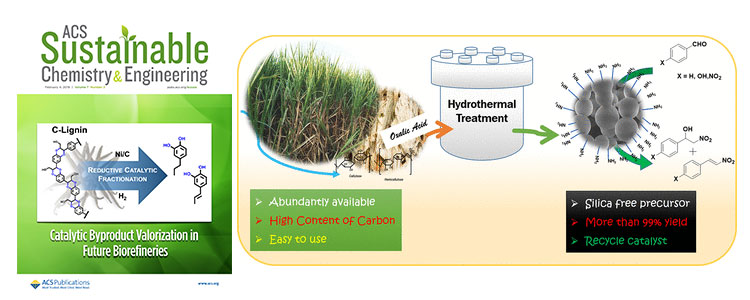Prof. Manoj B. Gawande, delivered an invited lecture on the topic “Synthesis and Catalytic Applications of Nanomaterials” on 5th-7th December 2019 at Sant Gadge Baba University, Amravati.
5th - 7th December 2019.

Prof. Manoj B. Gawande, joined Institute of Chemical Technology Mumbai-Marathwada Campus, Jalna. He joined as Associate Professor in Chemistry.
Heartly Congratulations………!!!
04.09.2019
Prof. Manoj B. Gawande, joined Institute of Chemical Technology Mumbai-Marathwada Campus, Jalna. He joined as Associate Professor in Chemistry. He will be teaching various chemistry courses including organic chemistry and inorganic chemistry. His research area focused on single atom catalyst, nanotechnology, bening organic transformations, Carbon materials and heterogeneous catalysis.
RCPTM discovered single mixed metal atoms for the oxidative coupling of amines and the oxidation of benzylic C-H bonds toward high‐value pharmaceutical synthons.
27.02. 2019
In this research work, 2D mixed‐valence SACs performs flawlessly in two O2‐mediated reactions: the oxidative coupling of amines and the oxidation of benzylic C-H bonds toward high‐value pharmaceutical synthons. High conversions (up to 98%), selectivities (up to 99%), and recyclability are attained with very low metal loadings in the reactions. The synergistic effect of Cu(II) and Cu(I) is the essential part in the reaction mechanism. The developed strategy opens the door to a broad portfolio of other SACs via their coordination to various functional groups of graphene, as demonstrated by successful entrapment of FeIII/FeII single atoms to carboxy‐graphene.
Advanced Materials, 2019, 1900323. Inside Cover Page (IF-25.08)
Web: https://onlinelibrary.wiley.com/doi/abs/10.1002/adma.201900323

Doke et al. article entitiled “Utilization of Waste Biomass for the Synthesis of Functionalizable Support for Covalent Anchoring of Active Organo catalyst” publisned in ACS Sustainable Chemistry & Engineering, 2019. A collaboration with Dr. Biradar, CSIR, Bhavnagar.
Synthesis of new nanostructured carbon materials from a naturally abundant carbon source has become one of the important way to utilise natural biomass as well as waste generated during processing of raw biomass due to its cost-effectiveness and the applications in catalytic transformations. Gade et al. reported the synthesis and characterization of carbon spheres from readily available sugarcane bagasse as well as D-glucose for comparison and covalent functionalization by organoamine onto the carbon surfaces via condensation of the hydroxyl group with trimethoxysilanes. Carbon microspheres (BCM) synthesized from agricultural waste residue (sugarcane bagasse) by a low temperature hydrothermal process (LTH) using oxalic acid as a dehydrating agent in single step. These BCMs is uniform in size and bear many −OH, −COOH, and carbonyl functional groups that provide different functionalization to create a hydrophilic surface using alkylamine which generated a basic catalyst which is highly efficient for the Henry reaction. Utilization of biomass waste to devlop a novel catalyst and its applications are very well explained in this article.
ACS Sustainable Chemistry amd Engineering, 2019, 7, 3018–3026. (IF-6.97)
Web: https://pubs.acs.org/doi/abs/10.1021/acssuschemeng.8b04430

Prof. Gawande invited book chapter entitled “Support Morphology-Dependent Activity of Nanocatalysts” published in The Royal Society of Chemistry, 2019.
In this book chapter the morphology-dependent catalytic performance of various supported metal nanocatalysts (Au, Pd, Pt, Co, Cu and Ru) deposited on oxide supports (cerium oxide and zinc oxide) with varying morphology is discussed. The nanoscale synthesis of metal nanoparticles and their deposition on nanosupports (CeO2 and ZnO) with diverse morphologies having unique properties to nanocatalysts with the distinctive metal-support interactions. These nanocatalyst having various applications in industrial reactions such as carbon monoxide oxidation, ammonia synthesis, the water–gas shift reaction, methanol steam reforming. This chapter focuses on the fundamental understanding of the vital relationship between the support morphology and the ensuing catalyst reactivity, providing a new direction to the design and development of highly efficient heterogeneous catalysts.
Book Chapter in “Nanoparticle Design and Characterization for Catalytic Applications in Sustainable Chemistry”
The Royal Society of Chemistry, 2019, pp. 84-114. “Invited Manuscript”
Web: https://pubs.rsc.org/en/content/chapter/9781788016292-00084/978-1-78801-629-2
Pieta et al. work entitled “Electrocatalytic methanol oxidation over Cu, Ni and bimetallic Cu-Ni nanoparticles supported on graphitic carbon nitride” published in Applied Catalysis B: Environmental 2019.
Methanol is one of the important for C-1 chemical feedstocks and used to synthesis of many other fine chemicals by addition reaction, electrocatalytic oxidation. Pieta et al. reported one pot hydrothermal synthesis of stable, inexpensive, and active anode materials consisting of Cu, Ni, and Ni–Cu nanostructures embedded in ultrathin two-dimensional (2D) carbon nitride (g-C3N4) nanosheets. These developed electrocatalysts having high methanol oxidation reaction (MOR) efficiency, stability, and performance for the electrooxidation of methanol in direct methanol fuel cells (DMFC) application. In which nanosized Ni particles dispersed finely over g-C3N4 are very active electrocatalysts for MOR reaction. The result in research article represent an important step towards light-enhanced electro-reactive systems and sensors in which heterojunction formation can facilitate electron-hole separation and enable more efficient energy transfer.
Applied Catal. B. Environ., 2019, 244, 272-283. (IF-14.22)
Web: https://www.sciencedirect.com/science/article/abs/pii/S0926337318310439


